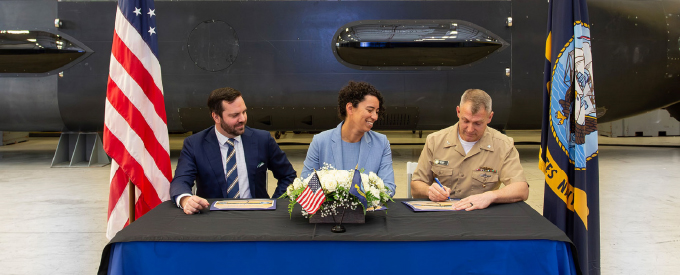2024-01-08
Submarine Orca’s Debut Signals Sea Change in Naval Warfare
Brace yourselves for a technological plunge — the U.S. Navy just took a giant leap forward with the delivery of its first Extra Large Unmanned Undersea Vehicle (XLUUV) Test Asset System, designated XLE0, from the manufacturer Boeing.
This submarine, named “Orca,” marks a new era in undersea dominance, designed to navigate the ever-shifting depths and contested waters of the future.
The delivery of XLE0 marks the culmination of a decade’s worth of research, design, manufacturing and testing by the Program Executive Office for Unmanned and Small Combatants (PEO USC) and the Unmanned Maritime Systems Program Office (PMS 406).
XLE0 commenced its in-water trials in Spring 2023 in Huntington Beach, California. Insights gained from these tests will directly inform the development of Orca XLUUV 1 through 5, slated for future construction and deployment within the Navy.
Autonomous Dominance
Orca XLUUV represents a leap in autonomous, unmanned diesel-electric submarines, featuring a modular payload section primed for executing diverse, mission-critical tasks vital to fortifying the Navy’s undersea dominance.
Engineered to flexibly accommodate an array of payloads, it seamlessly integrates sensors, communication systems, and specialised components, perfectly aligning with the evolving demands of naval operations.
Bolstered by its long-endurance capability, the Orca XLUUV stands as a testament to unparalleled autonomy, capable of operating seamlessly for extended durations. This endurance opens the doorway to sustained operational presence.
Moreover, this capability simplifies mission effectiveness, offering an augmented capacity to execute critical tasks and manoeuvres beneath the waves. Such a capability ensures heightened adaptability and responsiveness, enabling the Orca XLUUV to excel in prolonged missions while maintaining peak performance and operational readiness throughout its deployment.
Capt. Scot Searles, programme manager of the Unmanned Maritime Systems (PMS 406) program office, stated: “This has been a very busy year for the XLUUV team and their hard work is culminating in delivery of the Navy’s first-ever unmanned diesel-electric submarine. We look forward to continued success with our Boeing teammates in fielding this important capability for the warfighter.”
Ann Stevens, Boeing Maritime and Intelligence Systems vice president, noted: “I’ve had the pleasure of witnessing our team bring this first-of-its-kind capability to life, and I’m proud of their innovation, perseverance and commitment which has yielded the most advanced UUV in the world.”
Rigorous Evaluations
Benefiting from a robust collaboration with the Navy, the Orca has undergone a comprehensive series of at-sea testing, encompassing a multitude of phases designed to meticulously assess its capabilities.
These rigorous evaluations have spanned above and below surface manoeuvres, serving as a showcase of the vehicle’s prowess. Through these meticulously orchestrated tests, Orca has showcased its strength, proving its mettle in a range of maritime environments.
From surface manoeuvres that demonstrate its agility and surface-level competency to delving below the waves to exhibit its prowess in underwater operations, each phase of testing has been a testament to the vehicle’s effectiveness.
Boeing’s Orca stands as the culmination of over 50 years of expertise in crafting and operating undersea vehicles.
Pioneering Path
Echo Voyager, a groundbreaking vehicle in its class globally, embarked on at-sea testing in 2017, heralding a new era in naval technology and laying the groundwork for the US Navy’s Orca XLUUV programme.
It has logged over 10,000 autonomous operational hours, traversing extensive nautical distances, and rewriting the boundaries of traditional Unmanned Undersea Vehicle (UUV) limitations.
Measuring 51 feet in length, it boasts a modular payload section spanning up to 34 feet and 2000 cubic feet, surpassing conventional size constraints and accommodating diverse mission profiles. Its design allows for payloads extending beyond its core envelope, enhancing its versatility for an array of missions previously deemed unattainable.
The XLUUV harnesses a Kalman-filtered Inertial Navigation Unit, reinforced by Doppler Velocity Logs and depth sensors, ensuring superior directional accuracy.
Echo Voyager is complete with an extensive internal and external payload volume and available energy capacity, expanding the parameters of what is possible in current unmanned undersea systems.
The vehicle’s sophisticated autonomy empowers it to operate continuously at sea for months on end, presenting a cost-effective and mission-ready solution compared to conventional UUVs.


No Comments